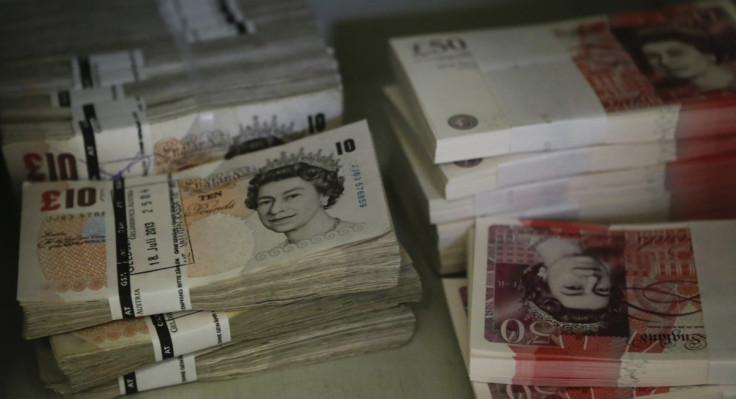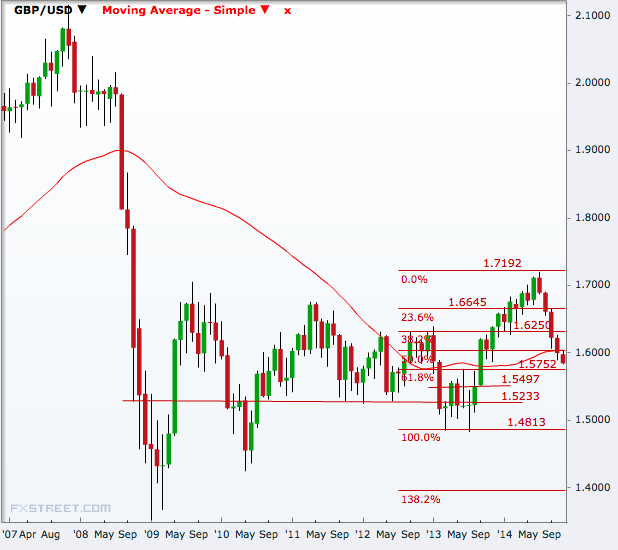UK's Inflation Report Key With Pound Under Pressure and Likelihood of Deeper BoE/Fed Divergence

The British pound managed to end higher on Friday as US non-farm payroll data came in weaker than expected, but with the data not showing any major challenges for the US labour market and the UK having no fresh data in its kitty to boost its hawkish stance, the BoE inflation report next week may push the currency to new lows.
Pound Move
The GBP/USD pair ended Friday 0.27% higher at 1.5876, moving off a 14-month low of 1.5790 hit earlier in the day. The sterling has been on a steady downtrend since July this year, losing ground from a near six-year high of 1.7192.
The UK currency has since weakened by more than 14% against the greenback to the weakest level hit on Friday and the trend is still downward, technically as well as fundamentally, with no major data in the recent past coming in strong enough to outsmart the Fed's reasons for making the dollar tighter.
The Bank of England left policy rates unchanged at the review meeting on Thursday, further strengthening the view that the rate differential of the BoE with the US will move more in favour of the US.
US Data and Dollar
The US initial jobless claims for the week to 1 November came at 278,000 down from 287,000 while analysts were expecting a more moderate fall towards 285,000.
The Q3 non-farm productivity rate eased, but less than expected, to 2.0% from 2.9% in Q2. The market expectation was for a sharper fall to 1.5%.
However, the more important non-farm payrolls figure was a weak show. Employment addition in October was 214,000, down from 236,000 in September and against analysts' forecast of a rise to 265,000.
The US unemployment rate, however, has dropped to a six-year low of 5.8% in October, revealing the strength of the labour market of the world's largest economy.
The USD index, the gauge that measures the strength of the greenback against a trade-weighted basket of major currencies, rose above the 88-mark last week for the first time since June 2010.
Significance of BoE Inflation Report
With the latest inflation and GDP figures from the UK coming as negative surprises, the BoE may soften its hawkishness in the upcoming report, thereby leading to a selloff in the British pound.
From the 2011 high of above 5% reading, the UK inflation rate has fallen to 1.2%, a multi-year low, by September. The GDP growth had recorded an eight-year high of 3.2% in the second quarter but has eased to 3% in the third quarter.
In the August report the BoE said: "Inflation is close to the MPC's 2% target and is projected to remain close to the target in the period ahead. As slack has been absorbed, financial market expectations of the date of the first Bank Rate rise have moved forward."
"But when Bank Rate does begin to rise, the pace of rate increases is expected to be gradual, with rates probably remaining below average historical levels for some time."
Now with inflation well below the target, the central bank communication on Wednesday will be of special importance for markets across the globe.
GBP/USD Technical Analysis
The pound has broken below the 50-period moving average on a monthly chart and is targeting the 61.8% Fibonacci retracement of March 2013-July 2014 rally at 1.5750. A break of that will open the doors to 1.5230 ahead of 1.4813, last year's low.
Data from the UK was largely mixed on Thursday. The year-over-year rise in the Halifax house prices index for the three months to October was 8.8%, down from 9.6% in September, and trailing a consensus of 9.1%.
However, the month-on-month industrial production growth for September rebounded to 0.6% from 0.0% in the previous month and year-on-year manufacturing output growth came at 2.9% beating analysts' forecast of 2.8%.

© Copyright IBTimes 2025. All rights reserved.






















